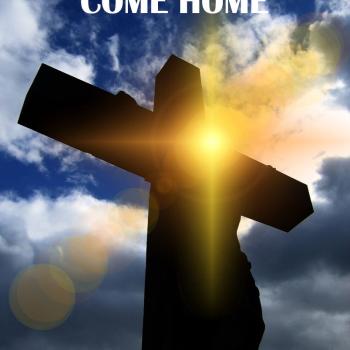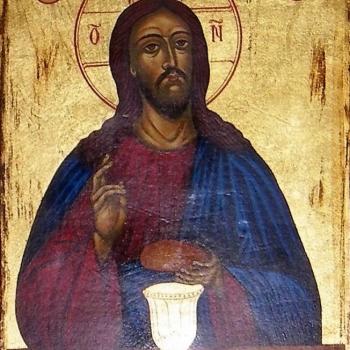Christ’s ascent into heaven after the resurrection should not be understood merely as a physical elevation, as if he took off like a rocket, going to outer-space. It is about a metaphysical elevation, that is, the completion of the transformation of human nature as it is glorified and brought into the eschaton. This is portrayed symbolically; we are presented with a description of the ascent where it is said that he ascended into the sky, into the heavens. This presentation was done in order to suggest that Jesus not only was glorified, but that he is also lord over all creation. This is not to say, historically, there might not be some element of him “flying” into the sky, but this was only done to help establish the symbol, for ultimately, his ascent took him beyond space and time, into the eschaton, showing to us the change which will take place in us at our own resurrection from the dead. Upon our entrance into the eschaton our bodies will become spiritualized as well, and like Jesus, we will find ourselves no longer bound by empirical laws.
Christ’s ascension is not meant to have us think he is now somewhere in space waiting for the time to come back down to earth; instead, we are to understand that he transcended the material sky, indeed, the whole material creation, to become a part of the spiritual reality from which material creation emerged. Material creation can be said to be “within” the spiritual or metaphysical reality, so that all material creation touches and is penetrated by the spiritual reality but not all of the spiritual reality is found within the material realm of being (as it extends beyond it). Because of this, Christ’s body, being spiritualized, is able to be encountered in the physical realm in a new way, explaining, for example, the way we can encounter him in the eucharist:
Thus the repetition of the Last Supper in anamnesis does not simply concern some earthly body and blood, just as Christ Himself after the Ascension is not present on earth in the same way that He was at the institution of the Eucharist. Hence, we are talking about the Body and Blood of Christ in a different sense, that is, in a Heavenly one. [1]
Physical being, with all the properties understood to be had by matter, cannot be used to explain the real presence. What we experience, and so what we receive, is physically bread and wine. This is what it means to say the accidents are that of bread and wine. However, that is not what they are in essence, what they are by nature. What we receive is Christ, and Christ’s fullness, which would be impossible if what we received was bound by and explained by physical laws. We experience the same fullness of Christ, his full person, in either a small or large piece of the eucharistic host. This makes no sense physically, but spiritually, it does, for the spirit is not bound by properties of space and time. The spiritualized body of Christ is no longer composed of material parts which can be cut up and split apart, but rather, it is one, and always one, and that oneness is what allows all those who partake of Christ to come together and become one, transcending their own material separation from each other. Everyone, no matter what location they find themselves in, no matter the physical size of the eucharistic species they receive, partake of one and the same Christ. They find themselves joined together in and through the oneness of Christ. The eucharistic presence is thus a great mystery because we do not truly understand the spiritual reality and how it works, even if we can apprehend it enough to get a sense of what is going on. And since Christ ascended, since he entered into the spiritual realm, making his very body spiritualized, he is now able to be with us until the end of the age, becoming the living bread which also “descends” to all creation, even into the “lowest” parts of it:
But when this bread descends, look how far it descends, not just to the earth, but to the farthest below the earth. For the one who descends is also the one who ascended far above the heavens. [2]
Thus, the ascension is connected to Christs’ everlasting presence with the faithful, and with it, the eucharist, for it tells us that Christ truly ascended so as to no longer be bound by material laws. His body is truly his body, but it is now glorified, it is spiritualized, and that spiritualization is presented both in the glory of the resurrection, where he is alive and will die no more, but also in the ascension, where he shows us that all things can and will be taken with him into that glory, that all things will join him in transcending material, temporal being and find their way to the eschaton. St. Albert the Great pointed out that this is also connected to the transfiguration, so that the glory we see revealed in the transfiguration, the glory of Christ’s divinity, is able to serve as the basis for the resurrection and the glorification of Christ’s humanity, and the glorification of Christ’s humanity then touches all creation, all material being, so he not only shares that glory with all creation, those which partake of it will find themselves being assumed by Christ so that they can find their proper place in the eschaton:
On the other hand, the potential for Christ’s resurrection is proven by the Transfiguration, whereas the act [of his resurrection] is proven by the appearances that follow after the resurrection. Moreover, the state of glory in both, namely in the head and in the members, is proven by Christ’s Ascension and the ascension of those who ascended with Christ. [3]
We can receive and experience a share of that glory now with communion. The eschaton is immanent, revealed in the already and not-yet relationship we have with it. For it is with us, and yet we have not yet entered into it. We experience a share of the glory here, revealing to us a foreshadowing of the glory and deification which is to take place when we enter into the eschaton ourselves. And so, as Bulgakov said:
The “transmutation” of the earthly elements, the bread and wine, into the Body and Blood of Christ, it is clear, cannot be limited in this connection only to the earthly state of the Lord’s humanity, but should contain in itself all that He is: that is, not only what is proper to our world, in which He abided until His Ascension in, glory, but also all the things that followed. And all of them happened in their turn, and yet they are connected to each other by the forms of the Lord’s corporeality in His sacrificial self-immolation. [4]
The eucharist, though it comes to us in and through the glory of the resurrected Christ, is the same person, the same Christ who willingly took on the cross so as to show the world the love God has for it. Just as we do not partake merely of a part of Christ when we partake of the eucharist, we do not partake of only a part of Christ’s person when we receive communion. Christ’s person is not divided into parts. It is one and the same person who died that was resurrected; it is one and the same person who “came down from heaven” who then “ascended into glory.” When we partake of the eucharist, we receive the Christ who gave his all to us in his self-emptying, sacrificial love, making it truly a sacrifice, even if it is much more than that, as we also receive the glorified Christ who, thanks to his resurrection, has brought about the restoration of all things. This is why the ascension, though important, must not lead us to ignore the kenosis behind the incarnation, for the two are one, even as Christ is one.
[1] Sergius Bulgakov, The Eucharistic Sacrifice. Trans. Mark Roosien (Notre Dame, IN: University of Notre Dame Press, 2021), 30.
[2] Origen, Homilies on the Psalms: Codex Monacensis Graecus 314. Trans. Joseph W. Trigg (Washington, DC: CUA Press, 2020), 337 [Homily 4 on Psalm 77].
[3] St. Albert the Great, On Resurrection. Trans. Irven M. Resnick and Franklin T. Harkins (Washington, DC: CUA Press, 2020), 96.
[4] Sergius Bulgakov, The Eucharistic Sacrifice, 32.
Stay in touch! Like A Little Bit of Nothing on Facebook.
If you liked what you read, please consider sharing it with your friends and family!
N.B.: While I read comments to moderate them, I rarely respond to them. If I don’t respond to your comment directly, don’t assume I am unthankful for it. I appreciate it. But I want readers to feel free to ask questions, and hopefully, dialogue with each other. I have shared what I wanted to say, though some responses will get a brief reply by me, or, if I find it interesting and something I can engage fully, as the foundation for another post. I have had many posts inspired or improved upon thanks to my readers.









